Plastic water containers: types, advantages and disadvantages + recommendations for selection
The water supply outside the city is unstable, so residents need to create an additional reserve of water for irrigation, bathing and other domestic needs.
In addition, tap water outside the city may be unsuitable for food purposes and owners of country houses should take care to create a drinking water reserve. It is best to use plastic water containers to store liquids.
In this material we will talk about the types of plastic water containers, their manufacturing technology, and also give some useful tips on choosing.
The content of the article:
Manufacturing technology of plastic containers
Thanks to the production technology of polymer containers, they can store technical and drinking water for a long time. Therefore, they are in demand both in summer cottages and for farming in a private home.
Water tanks are produced using seamless technology. The material for production is plastic in sheets, which, according to international quality criteria, is environmentally friendly, safe and durable. It is convenient when creating products, as it is easy to cut and weld.
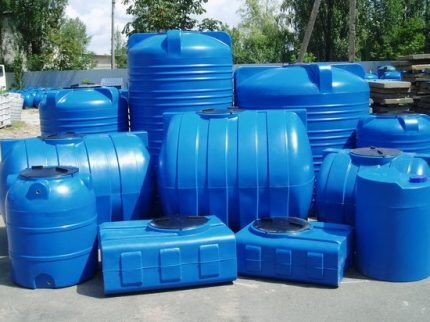
To make tanks, sheets of plastic are heated, shaped into the desired shape and secured together by seamless welding using welded rods.
The heated material is plastic and easy to mold. Therefore, at this stage, additional parts are installed.
Depending on the purpose of the storage tank, it can be equipped with:
- fittings;
- bends;
- flanges;
- shut-off ceilings;
- pumps;
- handles for transportation;
- drain;
- heating element;
- stiffening ribs;
- legs.
After giving the product the required shape, the finished tank must cool. After hardening, it is sanded in places where sheets are joined and additional elements are installed.
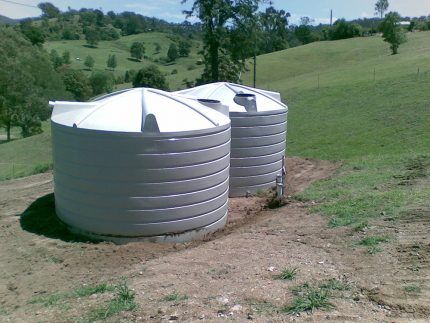
Polypropylene containers must be purchased in accordance with their intended purpose, therefore, before choosing a container for the dacha or for agricultural needs, you need to decide on the package.
At the customer's request, the tank can be equipped with additional accessories:
- float to visualize the liquid level;
- galvanized metal frame for added strength;
- cover and tray, for outdoor use;
- lid with an air valve to preserve the properties and freshness of drinking water.
Conscientious manufacturers use certified equipment and materials. The consumer, in this case, receives the product without additional seams, from a material of a homogeneous fraction.Such a product will be durable, environmentally friendly and reliable in operation.
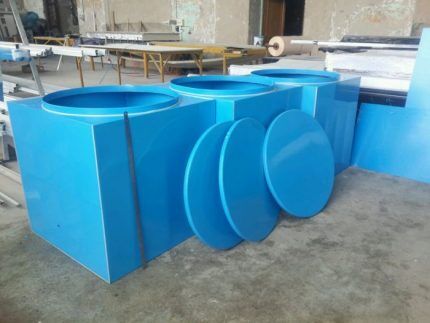
Violation of technology during the production process reduces the service life of plastic tanks. Some products are initially unsuitable for use. To avoid such troubles, the company must issue a quality certificate for the product.
Pros and cons of polyethylene tanks
The advantages of plastic tanks are related to the material from which they are made.
Therefore, the main advantages of polyethylene water containers are:
- Low cost. Due to the unstable situation in the financial market, the price of raw materials is increasing. Prices for finished products follow the same trend, but in comparison with tanks made from other materials, the cost of plastic products is significantly lower.
- Light weight. Transportation and loading of polypropylene containers allows you to minimize energy costs. Plastic barrels for transporting liquids, installed on the frame or body of a car, reduce the load and facilitate installation and dismantling of the transportation system.
- Plastic is resistant to rotting, corrosion, and detergents. In this regard, the product retains its attractive appearance for a long time.
- Material structure repels UV rays, so the properties of water stored for a long time in a plastic container will not change, even if the tank was located outside and not in the shade.
- Temperature Range, at which the product can be used without loss of properties - from -40 to +50°C.
- Term of use storage tanks for water made of polypropylene, depends on operating conditions, location, and ranges from 25 to 50 years.
Plastic tanks can be installed indoors and outdoors. Moreover, outdoor containers can be placed on a podium, on the ground, or buried in the ground.
When placed underground, the first drawback is revealed: frozen groundwater can push the lightweight structure out. Optimal grounding and holding structure are required to preserve the water storage tank.
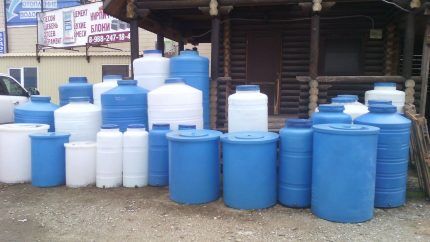
If the temperature outside for a long time is close to the lower limit, you should move the container to a heated room. In winter, it is necessary to completely drain the water, since its possible expansion will lead to deformation of the walls of the bowl.
When drinking water from a polyethylene tank that is not intended for food purposes, you can cause harm to your health, since when technical plastic of grade 03-07 interacts with water, and when they are heated, hazardous substances are released - bisphenol and formaldehyde.
If used correctly, these shortcomings will not affect the quality of water in the containers.
Types of plastic tanks
Storage containers for water made from polymers vary in shape, volume, color, material and purpose. When choosing a suitable tank, it is necessary to analyze which characteristics of the product will be optimal for meeting household needs.
Material for production
Light polymers are used to make containers: polyethylene and polypropylene. Polyethylene products They are used in everyday life for storing drinking and industrial water.
Polypropylene tanks suitable for use in industrial plants and factories. Dense, stable containers for technical and chemical liquids are made from polypropylene sheets.

Plastic barrels for drinking water are made from pure food-grade polyethylene. This material ensures the preservation of the chemical composition of water and prevents the proliferation of putrefactive microbes and bacteria.
There is a technology where the base material is coated with a special antiseptic coating on the inside of the tank. The inner, white layer protects the liquid from blooms and bacteria, and the outer, blue, creates a barrier to the penetration of sunlight.
To treat double-layer drinking water storage tanks, abrasive cleaning agents should not be used so as not to damage the integrity of the thin coating.
Difference between containers by color
Polyethylene containers are available in four colors: white, blue, green and black.
Blue tanks are universal and are used for storing food and process water outdoors and indoors. Since the dense layer of dark blue plastic does not transmit UV rays, water, even after long-term storage, does not lose its chemical properties and does not bloom.
Polyethylene green container, similar in properties to products of blue and dark blue shades. The choice of a green or blue tank is based on the personal preferences of the buyer.
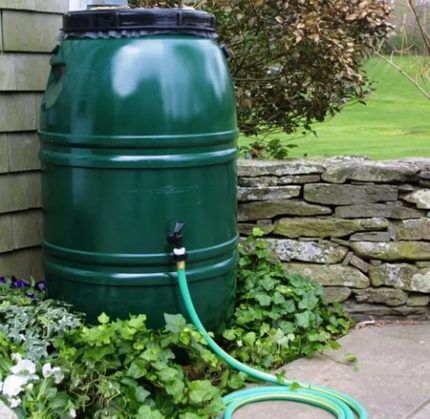
White canisters should be stored indoors without natural light, since light plastic does not protect the liquid from possible reactions. White tank walls have an advantage over colored ones only in that you can control the amount of liquid in the tank.
Black containers intended for watering or for arranging a summer shower. Such products do not transmit UV rays and get very hot in the sun. Therefore, underground tap water quickly heats up and becomes suitable for bathing and watering garden crops.
Storage volume and shape
Storage containers have different capacities. The smallest ones hold 20 liters of water, the largest ones – 10 tons.
To transport drinking water to the dacha, it is advisable to purchase containers with a volume of 20-50 liters. For arrangement summer shower Tanks of 100-200 liters are in demand.
If the supply of tap water is unstable, then a container with a capacity of 1000-2000 liters is suitable for irrigation and domestic needs.
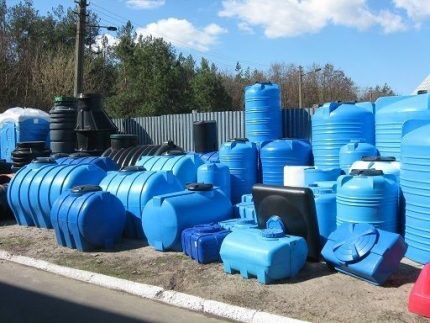
Tanks for 3, 5 and 10 cubic meters of water are used for industrial purposes and for transporting liquid and bulk cargo in special vehicles.
Polypropylene water tanks come in various shapes. Therefore, both the cottage owner and the summer resident will select the best option for the bowl, based on the capabilities and purpose.
Cylindrical tanks They take up minimal space, so they are used in bathhouses and homes.
Rectangular universal containers for storing liquids can be located underground and on the surface. A vertically standing rectangular tank significantly saves space.
Cubic tanks They have a large volume and a wide neck opening for easy filling. When installing the bottom tap and installing the barrel on the podium, complete drainage of water is possible.
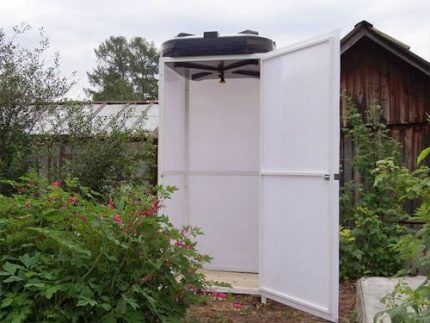
Flat elliptical or extended conical The tanks are installed on the roof of the summer shower. The shape, when the lower part is wider than the upper, allows you to increase the pressure of the liquid. For ease of filling, such containers are equipped with a wide neck opening.
This variety will allow you to install a water container in any free corner without losing useful space, even if the country house or plot has a small area.
The use of plastic tanks in the country
Living in a private country house or in a summer cottage, plot owners have to adapt to field conditions. A serious problem for summer residents is organization of water supply plot.
The low price determines the demand for plastic tanks. Such containers are used for collecting rainwater, irrigating the lawn and watering agricultural plants, arranging seasonal showers and drinking water.
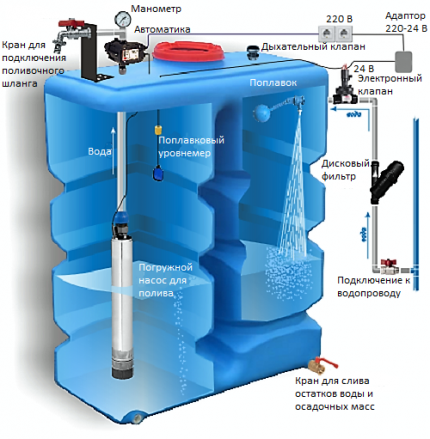
In addition, separate tank models are used for the device autonomous sewerage. For people who permanently live outside the city, in the absence of a sewage disposal channel, the installation of this engineering system is necessary.
Tips for choosing a polyethylene storage tank
For the manufacture of tanks, durable synthetic material is used - plastic, which ensures long-term operation of the products.
If its quality and product manufacturing technology do not meet existing standards, then the container will last half the guaranteed period or, with minor physical impact, will immediately become unusable.
Therefore, when buying a plastic tank, you need to take into account tips that will help you purchase a truly high-quality product.
Tip No. 1 - certificate of conformity
When purchasing a water storage tank, it is important to obtain a quality certificate for the product. Since the information in the document indicates that the product is made from certified raw materials using working equipment.

Obtaining a certificate of conformity is important when purchasing a drinking water tank. If the bowl was made of plastic grades 03-07, under certain conditions it releases life-threatening substances. Therefore, before paying, you must make sure that the container was cast from primary food grade polymer 01 and 02.
If this document is available, it is easier for the consumer to return the product to the seller if there are complaints about the quality.
Tip #2 – appearance
When examining the water tank externally, you need to make sure that there are no uneven walls.To do this, you should pay special attention to the convex parts of the container, and if in any area the plastic has a lighter shade or bends under finger pressure, then it is better to refuse to purchase this product.
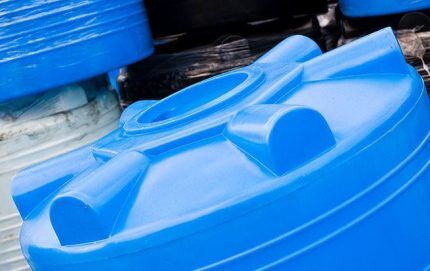
In addition, it is important to ensure the quality of the seams, or rather, their absence. High-quality connections are almost invisible, as they are made using seamless welding. Additional seams are excluded on a certified product.
The connection points of additional elements: bends, flanges, drains, handles, etc., must be thoroughly sanded.
Tip No. 3 – convenient transportation
If you plan to transport water to your summer cottage, you should consider plastic tanks equipped with special grooves.
By means of one or several recesses in the base, the container is tied and secured in the trunk or car body.
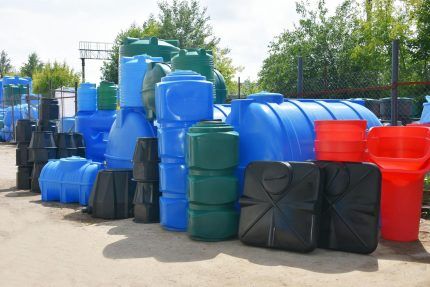
Conclusions and useful video on the topic
Purpose of plastic containers depending on volume and shape:
How to install the inlet and outlet fittings in a plastic container:
A lot of problems in the country and in a private home can be solved with the help of plastic water containers. The low price of polyethylene products, lightweight and durable construction contribute to the widespread use of polyethylene barrels indoors, outdoors and underground.
If your water needs change, you can change the tank without significant investment.
If you still have questions about the topic of the article, you can ask them in the block below, and we will try to give them a very clear answer.




I live in a rural area. I only have a plastic barrel at home. Everything in the yard is metal. Although they become covered with rust, they are strong and do not crack like plastic ones from an accidental touch or impact. In addition to this, they have another significant disadvantage. Under the influence of heat, and in our summer it can be forty degrees, they lose their shape and become distorted. Although such barrels are inexpensive, they have a short service life. Even if I see that the price for them is cheap, I avoid them in stores.
Plastic, of course, comes in different forms, but at 40 degrees the barrel should not be deformed. Softening of most types of plastic occurs at 80 degrees Celsius and above. And plastic has many advantages - both price and durability. So it’s in vain that you slander him.
I placed a blue polypropylene barrel with a capacity of 50 liters on the outdoor shower. Despite the color, the walls still transmit some of the sun's rays. The water begins to bloom on the third day. A layer of green flakes forms on the walls. But our neighbors have an iron barrel of 200 liters, and there is no such problem. Maybe it's because the lid on my tank doesn't close tightly? So the neighbors also have it covered with a sheet of plywood. In short, the tank needs to be changed, but for what?
Hello. You understand that sunny color only accelerates the development of phytoplankton already contained in water from the air or liquid medium.To prevent early flowering, use special reagents, buy black Eurocubes or paint an existing barrel black.
It is, of course, necessary to close the barrel better. Before these procedures, rinse the tank and supply hose. Also, if the reason is the high content of organic matter in the water, the well is disinfected and filters are installed.
Hello. I want to choose a plastic container for drinking water with a volume of 1.5-2 cubic meters for a private house, what should be the thickness of the plastic and what should I pay attention to, please tell me